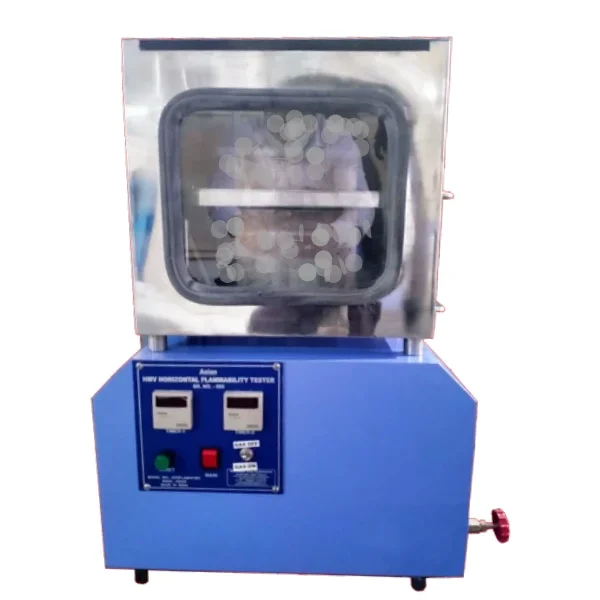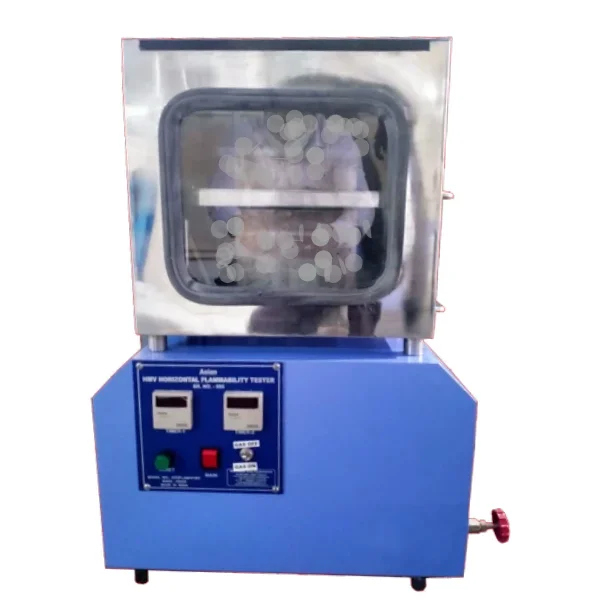
A Horizontal Flammability Tester is a laboratory instrument used to assess the flammability characteristics of materials, especially textiles and flexible materials. The test helps determine the ease with which a material ignites and its subsequent burning behavior. This information is crucial for ensuring the safety and compliance of materials used in various products. Here are key features and aspects of a Horizontal Flammability Tester: Test Principle: The tester is designed to ev....
A Horizontal Flammability Tester is a laboratory instrument used to assess the flammability characteristics of materials, especially textiles and flexible materials. The test helps determine the ease with which a material ignites and its subsequent burning behavior. This information is crucial for ensuring the safety and compliance of materials used in various products.
Test Principle: The tester is designed to evaluate the horizontal burning characteristics of a specimen when exposed to an open flame or other ignition source.
Ignition Source: A controlled flame source, often a specified gas flame, is applied to the surface of the test specimen. The duration and intensity of the flame exposure are controlled according to relevant testing standards.
Specimen Preparation: Test specimens, usually of specified dimensions, are prepared and mounted horizontally for testing. The samples may represent materials used in garments, upholstery, or other applications where flammability is a concern.
Test Conditions: The test conditions, including the size and type of flame, the duration of exposure, and other parameters, are typically defined by relevant standards. Common standards for horizontal flammability testing include ASTM D6413 and various ISO standards.
Observation and Measurement: During the test, observations are made regarding the material's ignition time, flame spread rate, and other relevant characteristics. The extent of burning and any after-flame or afterglow is also noted.
Pass/Fail Criteria: The test results are compared against predetermined criteria specified in standards or regulations. Materials that meet these criteria are considered to have passed the test, indicating that they exhibit a certain level of resistance to ignition or flame spread.
Safety Considerations: Safety features are often incorporated into the design of the tester to prevent uncontrolled fires and ensure the safety of laboratory personnel. This may include flame arrestors and other safety mechanisms.
Application: Horizontal flammability testing is commonly applied to textiles, fabrics, and other materials used in clothing, furnishings, and various consumer products. Compliance with flammability standards is especially critical for products intended for use in environments where fire safety is a concern.
Quality Control: Manufacturers may use horizontal flammability testing as part of their quality control processes to ensure that materials used in their products meet safety standards and regulations.
It's essential to conduct flammability testing in accordance with relevant standards to ensure that products are safe for consumers and meet regulatory requirements. The specific standards and testing methods may vary depending on the type of material and its intended use.

Corrosion test chamber is a great laboratory test equipment widely used in metal...
Cyclic Corrosion Salt Spray Chamber manufactured by Sigma Machines – the world...
Sigma Machines CASS tester is designed keeping in mind the relevant tester stand...
Ensure the quality and durability of your materials with our reliable Double Hea...
SIGMA Machines is counted among the best salt spray chamber manufacturers in Ind...
Enhance your testing capabilities with our advanced digital pounding tester...
Enhance your foam testing process with our advanced PU foam Indentation Hardness...
Enhance your yarn quality control with our reliable and efficient yarn strength ...
Get accurate results with our Shear Fatigue Tester for PU Foam...
Ensure precise measurements of soft materials with our reliable thickness gauge...
Enhance your understanding of ball performance using our reliable Ball Resilienc...
Asian Water Absorption Tester is Water Resistance Tester For Sole Leather- (Perm...
Discover the ultimate laundry solution with Laundrometer Digital Model - the per...
Enhance your testing process with Test Template D and achieve accurate and relia...
Ensure the safety of children's toys with our reliable and efficient flammabilit...
The humidity test cabinet provides a sample with the humidity that the materials...
Ensure accurate results with our advanced Bundesmann Apparatus Tester for compre...
A Hot air oven is a great tool for manufacturers to accurately test materials i...
hydrostatic testing equipment used for testing lateral pipes is located within a...
Enhance belt quality control with our Belt Flex Tester, providing accurate and r...
Rockwell Hardness Tester models are suitable for accurately testing the hardness...
Martindale abrasion machine is suitable for testing the pilling degree and abras...
Adhesion Strength Tester serves the purpose of measuring the peelability or perm...
ASIAN Bursting Strength Tester Machine is especially useful for measuring the pa...
Achieve superior strength and resilience with our cutting-edge tensile strength ...
Enhance your quality control processes with our reliable Impact Tester, providin...
Ensure accurate measurements of your drapes' performance with our reliable Drape...
Glow Wire Test Equipment is an important testing equipment which is used in the ...
The heat distortion temperature of the polymer in the test is identified as the ...
Range: 2000 lbs with 1 lbs least count digital display Elongations: Up to 9...
Torque Tester for Bottle Caps is one of the important instruments to calculate t...
The “ASIAN” Universal testing machine provide a relatively inexpensive way...
Asian Melt Flow Index Tester helping evaluate the flow properties of melted plas...
Size of the Test Specimen: 40 X 15 mm Distance between edge of the Crease...
Box Compression Tester is used to measure the box compression strength (BCT), sh...
Enhance your material testing capabilities with the advanced Demattia Flex Teste...
Enhance your understanding of material properties with our Oscillating Disk Rheo...
Enhance your scientific experiments with our Specific Digital Gravity ...
Looking for an accurate and reliable IRHD Rubber Hardness Tester? Look no furthe...
Explore the world of direct reading specific gravity balance through our informa...
Enhance your testing efficiency and accuracy with our state-of-the-art universal...
Discover the Cone Calorimeter Tester: Enhance fire safety with accurate and reli...
Enhance your testing capabilities with a state-of-the-art dry sand abrasion test...
.jpg)
Get In Touch With Us
See How your Business Can benefit With
Sigma Machines
Get Estimated Quote
